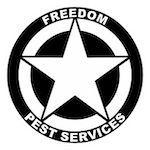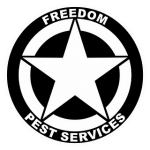PAPER WASPS
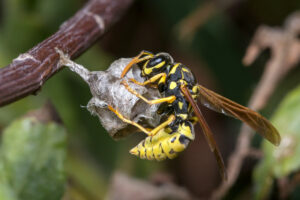 Paper wasps are about 3/4-1 inch long and are a dark brown black with yellow stripes. These pests spend most of their time gathering fibers from dead wood and plant stems, which they mix with saliva, and use to construct water-resistant umbrella shaped nests made of gray or brown papery material.
Paper wasps are about 3/4-1 inch long and are a dark brown black with yellow stripes. These pests spend most of their time gathering fibers from dead wood and plant stems, which they mix with saliva, and use to construct water-resistant umbrella shaped nests made of gray or brown papery material.
Paper wasps place their nests up off the ground in trees, on utility poles, under decks, under roof eaves, and in the corners of door frames. Paper wasps are social and are very quick workers. A paper wasp nest typically houses a couple hundred wasps and if their nest is somehow disturbed or destroyed, they are sure to have it rebuilt in the same spot within a couple of days. As social wasps, their first instinct is to always protect their nest, especially from ants who love to steal their larvae. Adult female paper wasps are the only ones that are able to sting, and their stings are very painful. In general, wasps are most active during the warmer months of the year, from spring to fall. This is when people are most likely to encounter wasps and should take precautions to avoid stinging incidents. During this time, wasps are actively foraging for food and building nests.
You’re outside working on the yard and look up to find a wasp or bee nest. Next time you’re at the store you grab bug spray, come home and treat the area. Next thing you know that nest is dead, but a new one has formed on the other side of the house. Wasp and bee removal can be a very tricky job. Luckily, our professional exterminators are highly trained in taking care of wasp and bee removal properly. We treat all wasps and bees except for honeybees. No worries though, if you have a honeybee issue we know someone that can help. Give us a call today to get started.
YELLOW JACKETS
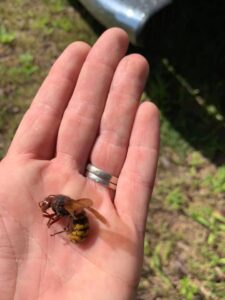 Yellow Jackets are known for their yellow and black bodies, defined thin waist and elongated wings. The average yellow jacket range in size from 3⁄8 to 5⁄8 inch long, with queens being significantly larger. They are known to be social wasps that live in colonies of thousands. They are ground nesters and most of their nests can be found under steps, cracks in the sidewalk or in bases of trees. These flying pests will do whatever it takes to defend their nest and will sting repeatedly if they feel threatened.
Yellow Jackets are known for their yellow and black bodies, defined thin waist and elongated wings. The average yellow jacket range in size from 3⁄8 to 5⁄8 inch long, with queens being significantly larger. They are known to be social wasps that live in colonies of thousands. They are ground nesters and most of their nests can be found under steps, cracks in the sidewalk or in bases of trees. These flying pests will do whatever it takes to defend their nest and will sting repeatedly if they feel threatened.
Some benefits of yellow jackets include the fact that they pollinate flowers and plants, and eat other harmful/annoying insects such as flies or mosquitos. Yellow Jackets are attracted to foods such as meats and sugary items, which is why they tend to frequent picnics and barbecues. Yellow jackets are particularly active during the summer and early fall when their populations are at their peak. At this time, they are often seen flying around in search of food and defending their nests. If you are having a problem, do not disturb them, call the professionals to remove them properly.
The best indications of an issue are seeing the yellow jackets themselves or finding their nest. Always be cautious if you see a nest nearby as there could be thousands of yellow jackets and they are known to be aggressive and attack if they feel threatened. They can sting you multiple times as well and for those who are allergic, their stings can also be severe.
If you have these pests roaming around the outskirts of your home, wasp and bee removal can be a very tricky job. Luckily, our professional exterminators are highly trained in taking care of wasp and bee removal properly. We treat all wasps and bees except for honeybees. No worries though, if you have a honeybee issue we know someone that can help. Give us a call today to get started.
HORNETS
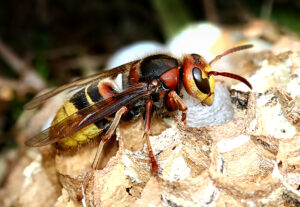 Hornets are yellow and brown and most reach about 3⁄8 inch long. They are aggressive creatures and will sting and bite you if they feel threatened. Many times hornets will build their nests in a cavity or wall of a hollow tree. They also damage trees and shrubs by gathering bark for nests and consuming the sap.
Hornets are yellow and brown and most reach about 3⁄8 inch long. They are aggressive creatures and will sting and bite you if they feel threatened. Many times hornets will build their nests in a cavity or wall of a hollow tree. They also damage trees and shrubs by gathering bark for nests and consuming the sap.
They also eat other insects such as grasshoppers, crickets, and other yellow jacket species. The most clear sign of an infestation is seeing the hornets themselves. There will also usually be a nest which will serve as their main hub and where most of them will gather.
We recommend that you do not get near the nest as it may cause them to become aggravated and attack. The sting of wasps can be dangerous. People who are stung by this pest can experience an anaphylactic shock which can be deadly if not given immediate treatment. Some stings can get off within a day if a deodorant with aluminum is applied, but it can get worse. Also, the venom of wasps can cause other wasps to be aggressive due to its pheromones.
Many times a nest will be by a dry area, in the cavity of a tree or even under playground equipment. If you have an infestation near your home, we suggest you contact us at Freedom Pest to ensure a safe removal. Our professional exterminators are highly trained in taking care of wasp and bee removal properly.
Quality Guarantee
Your satisfaction is one of our main priorities. That is why we gladly offer a warranty for all pest control maintenance programs & termite treatments.
Pet Friendly
Once our treatments have dried, everything is completely safe for pets. We even go the extra mile for furry friends and have all trucks fully equipped with dog biscuits!
Licensed
Unlike most pest control companies, 50% of our staff hold a pest control service license. These licenses allow us to provide expert services for South & North Carolina.
